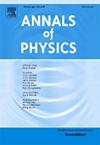Double-slit experiment revisited
IF 3
3区 物理与天体物理
Q2 PHYSICS, MULTIDISCIPLINARY
引用次数: 0
Abstract
The double-slit experiment is one of the quintessential quantum experiments. However, it tends to be overlooked that the build-up of the interference pattern involves single detection events with a random position and a random time of detection. Hence, a full theoretical account of this experiment requires the specification of the joint position and time distribution of detection at the screen, whose position marginal yields the famous interference pattern. The difficulty lies in what this distribution should be. While there are a variety of proposals for a quantum mechanical time observable , there is no consensus about the right choice. Here, we consider Bohmian mechanics, which allows for a natural and practical approach to this problem. We simulate this distribution in the case of an initial Gaussian wave packet passing through a double-slit potential. We also consider a more challenging setup in which one of the slits is closed during flight. To experimentally probe the quantum nature of the time distribution, a sufficient longitudinal spread of the initial wave packet is required, which has not been achieved so far. Without sufficient spread, the temporal aspect of the distribution can be treated classically. We illustrate this for the case of the double-slit experiment with helium atoms by Kurtsiefer et al. (1997), which reports the joint position and time distribution.
双缝实验重现
双缝实验是典型的量子实验之一。然而,容易被忽视的是,干涉图样的建立涉及具有随机位置和随机检测时间的单个检测事件。因此,这个实验的一个完整的理论说明需要在屏幕上指定检测的联合位置和时间分布,其位置边缘产生著名的干涉图。困难在于这种分布应该是怎样的。虽然对于可观测的量子力学时间有各种各样的建议,但对于正确的选择没有达成共识。在这里,我们考虑波西米亚力学,它允许一个自然和实用的方法来解决这个问题。我们在初始高斯波包通过双缝势的情况下模拟了这种分布。我们还考虑了一个更具挑战性的设置,其中一个狭缝在飞行期间关闭。为了实验探测时间分布的量子性质,需要初始波包的足够的纵向传播,这到目前为止还没有实现。在没有充分扩散的情况下,可以用经典方法来处理分布的时间方面。我们以Kurtsiefer等人(1997)的氦原子双缝实验为例说明了这一点,该实验报告了关节的位置和时间分布。
本文章由计算机程序翻译,如有差异,请以英文原文为准。
求助全文
约1分钟内获得全文
求助全文
来源期刊

Annals of Physics
物理-物理:综合
CiteScore
5.30
自引率
3.30%
发文量
211
审稿时长
47 days
期刊介绍:
Annals of Physics presents original work in all areas of basic theoretic physics research. Ideas are developed and fully explored, and thorough treatment is given to first principles and ultimate applications. Annals of Physics emphasizes clarity and intelligibility in the articles it publishes, thus making them as accessible as possible. Readers familiar with recent developments in the field are provided with sufficient detail and background to follow the arguments and understand their significance.
The Editors of the journal cover all fields of theoretical physics. Articles published in the journal are typically longer than 20 pages.
 求助内容:
求助内容: 应助结果提醒方式:
应助结果提醒方式:


